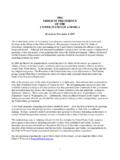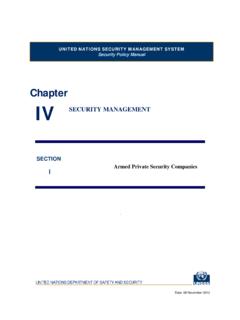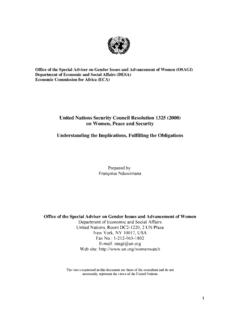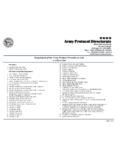Transcription of The United Nations Development Agenda: …
1 Economic &. S ocia l The United Nations Development agenda : Af f a irs Development for All United Nations D epar tment of Economic and Social Affairs The United Nations Development agenda : Development for All Goals, Commitments and Strategies agreed at the United Nations world Conferences and Summits since 1990. United Nations Preface The historic United Nations conferences and summits held in the past two decades generated an unprecedented global consensus on a shared vision of Development . These remarkable participatory processes, and the array of Development goals that were agreed through them, laid the groundwork for the Millennium Summit, at which a series of challenging time-bound goals and targets were adopted. Many were later collated as the Millennium Development Goals, which have suc- ceeded in galvanizing an exceptional momentum to meet the needs of the world's poorest.
2 This comprehensive set of Development goals, of which the MDGs are an integral part, has come to be called the United Nations Devel- opment agenda . It serves as the internationally shared framework for Development for action at the global, regional, and country levels. The agenda encompasses inter-linked issues ranging from poverty re- duction, gender equality, social integration, health, population, em- ployment and education to human rights, the environment, sustain- able Development , nance and governance. It includes as well systemic issues, such as the di erential impact of globalization, inequalities among and within countries, and greater participation of developing countries in global economic governance. And it also addresses the question of inter-linkages between Development and con ict. Two elements have permeated the content and character of the agenda since its inception.
3 First is a fundamental concern for equity and for equality of all persons, as human beings and as citizens. In my eyes, it is this struggle for equity and for equality that makes the United Nations so valuable. It is also, in many ways, what brings civil society to rally around the UN's participatory processes. This points up the second essential element: partnership. The conference process has engaged all the key stakeholders: governments, UN system orga- nizations, other intergovernmental and non-governmental organiza- tions, civil society, and the private sector. Moreover, the process has produced a global partnership for Development , with a framework for mutual accountability, which is now recognized as critical for advanc- ing progress towards all the Development goals. The United Nations Development agenda : Development for All iv This publication seeks to share the wealth of the United Nations Development agenda in a friendlier format for stakeholders of all sorts.
4 It reviews the decisions of the major conferences and summits held between 1990 and 2005 in an integrated manner and draws im- plications for current and future Development strategies. Above all, it should serve to make the conference and summit concepts and out- comes more accessible and more easily integrated to inform public discourse, policy debate and democratic decision-making on develop- ment issues. Jos Antonio Ocampo Under-Secretary-General for Economic and Social A airs June 2007. Contents 1. Goals and Commitments 1. 2. National Development Strategies 11. National Ownership of Country Strategies 11. Integrating Economic, Social and Environmental Policy 12. The Enabling Framework: Peace, Good Governance and Human Rights 13. Full and Productive Employment and Decent Work for all 17. Economic Policies 19. 3. Social Progress 23. Education and Training 23.
5 Health 25. Combating HIV/AIDS 28. Housing and Shelter 30. Water and Sanitation 31. Social Protection 32. Combating Drug Abuse 33. 4. Social Justice and Inclusion 35. Equity 35. Reducing Poverty 36. Nutrition 38. Social Inclusion 40. Gender Equality 41. Protection for Children 42. Opportunities and Support for the Ageing 43. Recognition of Indigenous Peoples' rights 44. Refugees and Internally Displaced Persons 45. The United Nations Development agenda : Development for All vi 5. Environmental Sustainability 47. Sustainable Consumption and Production 48. Climate Change and Energy 51. Desertification 52. Biological Diversity 52. Forests 53. Oceans and Seas 54. Disaster Reduction 55. 6. An Enabling International Environment 57. External Private Financial Capital Flows 57. External Borrowing and Debt 58. Official Development Assistance (ODA) 59.
6 Innovative Sources of Finance 61. International Trade 62. Transfer of Technology 64. Migration 65. 7. Reducing Inequality Between Countries 67. Africa 68. Least Developed Countries 69. Small Island Developing States 70. Landlocked Developing Countries 72. 8. Systemic Issues 75. Global Economic Governance 75. The Economic and Social Council 76. International Financial and Economic Institutions 77. 9. Challenges 79. Boxes Global Conferences and Summits 3. The Millennium Development Goals 7. 1. Goals and Commitments The rst paragraph of the Charter of the United Nations expresses the determination of the peoples of the world to promote social progress and better standards of life in larger freedom' and to employ interna- tional machinery for the promotion of the economic and social ad- vancement of all peoples'. Article 55 expands on these purposes: With a view to the creation of conditions of stability and well- being which are necessary for peaceful and friendly relations among Nations based on respect for the principle of equal rights and self- determination of peoples, the United Nations shall promote: a.
7 Higher standards of living, full employment, and conditions of economic and social progress and Development ;. b. solutions of international economic, social, health, and related problems; and international cultural and educational coopera- tion; and c. universal respect for, and observance of, human rights and fundamental freedoms for all. The world conferences and summits since 1990 have been the best attempt in the history of the United Nations to give concrete content to these objectives of the UN Charter. Although UN forums had long been the locus of policy debates, the conferences and summits of the past two decades were exceptional in responding to calls by leaders from many countries for the United Nations to more actively adopt the normative role outlined in the Charter by de ning values, setting goals, articulating strategies and adopting programmes of action in the di erent dimensions of Development .
8 They re ect, in turn, the fact that the UN is the political heart of the international system and . The United Nations Development agenda : Development for All 2. thanks to its now universal membership the international organiza- tion with the greatest legitimacy. Since its creation, one of the main aims of the United Nations has been to support and protect the disadvantaged, the weak and the vulnerable. Such conditions of adversity occur in a wide variety of forms from economic deprivation to social exclusion, lack of choices and even lack of freedom and at all levels from continents to coun- tries, regions within countries, communities and individuals. One of the over-arching purposes of each of the world conferences was to agree on remedies to these inequities. Within each Conference's spe- ci c area of interest, they all focused on the need, indeed the global responsibility, to address various inequalities by improving the situ- ation of the poorest, weakest and most vulnerable segments of the world community.
9 In this sense, it is perhaps symbolic that the rst of all the summits focused on children. Late in the 1980s, UNICEF proposed holding a World Summit for Children, and six countries Canada, Egypt, Mali, Mexico, Pakistan and Sweden initiated its planning. The Summit was organized with the support of UNICEF, the UN Secretariat and other UN agencies, and was held under the auspices of the UN Secretary- General. One hundred and fty-nine governments attended, includ- ing 71 Heads of State or Government. A World Declaration and a Plan of Action for the survival, protection and Development of chil- dren were adopted. The Declaration adopted by the Children's Summit made ten commitments, including: rati cation of the Convention on the Rights of the Child; enhancement of children's health through provision of clean water, sanitation and eradication of hunger; strengthening the status of women; respect for families; reduction of illiteracy; amelio- ration of the plight of child victims of racial discrimination, foreign occupation, exploitation, displacement and disasters; protection of children from the scourge of war; protection of the environment; and an attack on poverty.
10 The Summit also endorsed seven explicit goals including reduction of infant and child mortality by a third during the following decade and of maternal mortality by half; universal access to safe drinking water and sanitation; universal access to basic education and completion of primary school by at least 80 per cent of primary- school-age children; halving adult illiteracy by 2000; and protection of children exposed to armed con ict. The Plan of Action adopted policy recommendations for working towards the goals. Goals and Commitments 3. GLOBAL CONFERENCES AND SUMMITS. Event Year Children 1990. Education for All 1990, 2000. Least Developed Countries 1990, 2001. Drug problem 1990, 1998. Food Security 1992, 1996. Sustainable Development 1992, 2002. Human Rights 1993, 2001. Population and Development 1994. Small Island Developing States 1994, 2005.















